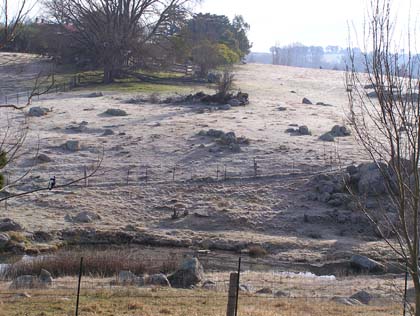
When I began planting my country garden, I had visions of French lavender hedges and geraniums in pots. By the end of summer that dream had become a reality. Then, one autumn morning, I discovered something very strange. Overnight the geraniums had turned brown and the lavender was drooping. Thinking that the plants needed watering, I gave them a generous soaking. For good measure, I trimmed off the worst of the drooping lavender stalks and removed the dead geranium flowers.
The next morning, I checked my garden, expecting a recovery. Instead, the lavender looked worse than ever. The remaining flower heads had begun to wilt, as though they were grieving for their lost companions. And the geraniums were barely recognisable. As I touched the leaves, they turned to dust in my fingers. What had happened, I wondered, to cause such havoc?
You guessed it. The culprit was that stealthy morning visitor – the dreaded frost! As a coastal gardener, I'd never experienced one before. Even now, when I know how destructive they can be, there are winter mornings when I find myself gazing out the living room window and marvelling at the white fields, glistening as if they’ve been dusted with crystallized sugar. But, believe me, the dark side of frost far outweighs its transitory visual delights.
So, how does a gardener fight back? You can monitor the weather forecasts and cover your plants in the afternoon or evening in anticipation of a frost. You can get up early and try to hose off the icy crystals – that is, if your hose isn’t frozen. You can accept the losses and plant suitable things next time. Or you can abandon the idea of a garden altogether and watch luxuriant weeds filling the space. (Wouldn’t you know it? Weeds are frost-hardy.)
What did I do? Something I should have done in the first place. I walked around town and checked out what was thriving in other people’s gardens. I even pinched some cuttings from a rock-rose in the garden of our old courthouse (ten cuttings; one survived to grow into a lush shrub from which I now plan to take more cuttings).
Then I visited the local nursery and sought expert advice. What I learned was this. Choose the right plants for your climate. Even then, protect them for the first few winters and allow your plants to acclimatise. Don’t remove frost-damaged tips until the frost danger has passed for the season – like a scab over a cut, they protect the ends of the stems. And don’t expect geraniums to survive the winter. Then again, they might surprise you in the spring with a burst of new growth.
Since then, I’ve accumulated plants that seem to do well in our harsh climate (hot, dry summers and bitter winters) – rock roses, of course, buddleia (summer lilacs) and real roses. Owing to the low humidity, my country roses don’t seem to have the fungal problems which afflict their city cousins.
Writers are fond of using the weather as a metaphor. Sometimes it works brilliantly; at other times it seems like a cheap trick. I have to confess I’ve incorporated a frost or two into my novel, MR CHEN’S EMPORIUM. Having read this article, you’ll know it isn’t merely a stylistic device I've thrown into the book to impress the reader. My feelings about the frost are real and visceral. So are those of my female protagonist, Angie Wallace, who hates frosts with a passion, even comparing them to Bram Stoker’s Dracula, creeping up to suck the life out of the little plants she holds so dear.
Angie’s right. The icy onslaught is likely to cause serious damage, and recovery can be a slow process. It may not happen this season, or even the next. And just when you start to bloom again, there may be setbacks. But slowly you will build frost-hardiness. And one day you may find that you have grown in ways you never imagined possible.
Deborah O'Brien
April, 2012
